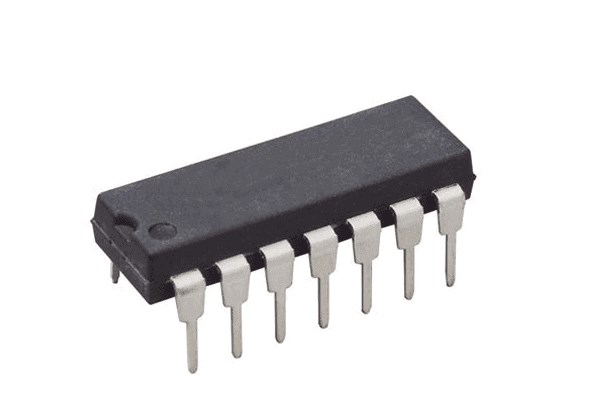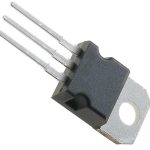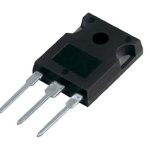The 74HC14 is a versatile hex inverting Schmitt trigger IC widely used in digital logic circuits. With its six independent inverters and Schmitt trigger input, this IC offers reliable signal processing and noise tolerance. From signal level shifting to waveform generation, the 74HC14 finds application in diverse electronic projects. In this blog, we will delve into everything you need to know about the 74HC14, including its functionality, practical uses, equivalent models, and notable features.
What is 74HC14?
The 74HC14 is an integrated circuit (IC) that belongs to the 74HC series of logic devices. It specifically refers to a hex inverting Schmitt trigger IC. The term “hex” indicates that it consists of six individual inverters within a single package, while “inverting” signifies that each inverter provides logical negation of its input signal. The “Schmitt trigger” feature incorporated into the 74HC14 enhances its noise tolerance and switching reliability.
What is the use of 74HC14?
The primary use of the 74HC14 is in digital logic circuits where signal processing and control are required. As a hex inverting Schmitt trigger, it finds application in signal level shifting, signal inversion, buffering, and general-purpose logic functions. The 74HC14 is commonly used for interfacing between different logic families, providing robustness against noise and ensuring stable transitions between logic states.
What is 74HC14 equivalent to?
The 74HC14 is equivalent to other hex inverting Schmitt trigger ICs such as CD40106, HCF40106, and MC14094. While there might be slight variations in voltage levels, power consumption, or pin configurations, these ICs share similar functionality and can be used interchangeably in most cases.
Pin out

Datasheet
Click here or the picture below to get the datasheet document of 74HC14 to know more details about it:
Features
- Hex inverting Schmitt trigger with six independent inverters
- Wide operating voltage range (typically 2V to 6V)
- Improved noise immunity due to Schmitt trigger input
- Compatibility with both CMOS and TTL voltage levels
- High-speed operation and low power consumption
- Overvoltage-tolerant inputs for easier interfacing
- Balanced propagation delays for synchronous applications
- Available in various package options, including DIP and SMD
Practical Applications
- Signal conditioning and interfacing in digital systems
- Oscillators and time-delay circuits
- Noise filtering and debouncing in switch inputs
- Analog-to-digital and digital-to-analog conversions
- Pulse shaping and waveform generation
- Logic level conversion and buffering
Compare 74HC14 With Other Models
74HC14 vs 74HC04
The 74HC04 is another hex inverter IC, but it does not have the Schmitt trigger feature found in the 74HC14. The primary difference between these two models lies in their input voltage levels and noise tolerance. While the 74HC14’s Schmitt trigger allows for improved noise immunity and more reliable switching, the 74HC04 operates on standard input voltage levels without the Schmitt trigger capability.
74HC14 vs 74LS14
When comparing the 74HC14 with the 74LS14, both are hex inverter Schmitt trigger ICs, but they belong to different logic families. The 74HC14 is part of the CMOS logic family, while the 74LS14 belongs to the TTL family. The main contrast lies in the power supply voltage requirements and switching characteristics. The 74HC14 operates at higher voltages and has lower power consumption than the 74LS14, which makes it more suitable for modern low-power applications.
74HC14 vs 74HCT14
The 74HCT14 is similar to the 74HC14 in terms of functionality as a hex inverter Schmitt trigger. However, the key distinction lies in the HCT series’ compatibility with both CMOS and TTL voltage levels. Unlike the 74HC14, which is strictly CMOS compatible, the 74HCT14 can interface with both CMOS and TTL devices seamlessly. This flexibility allows for easy integration into mixed-logic systems.
74HC14 vs CD40106
The CD40106 is also a hex inverter Schmitt trigger IC, but it differs from the 74HC14 in terms of voltage levels and power supply requirements. The CD40106 operates at higher voltages and has higher power consumption compared to the 74HC14. Additionally, the CD40106 has different pin configurations and may not be directly compatible with circuits designed for the 74HC14. These differences should be considered when selecting the appropriate IC for specific applications.

FAQs
What is hex inverter IC?
A hex inverter IC is an integrated circuit that consists of six individual inverters. Each inverter converts its input signal into its logical complement (i.e., high to low or low to high). Hex refers to the number six, indicating the presence of six inverters within a single IC package.
What is a hex inverter Schmitt trigger?
A hex inverter Schmitt trigger is a specialized type of hex inverter that incorporates a Schmitt trigger input. A Schmitt trigger is a circuit component that provides hysteresis, allowing it to better tolerate noisy or slowly varying input signals. By adding the Schmitt trigger feature, the hex inverter becomes more robust and less prone to false triggering caused by noise or signal distortions.
What is the purpose of a hex inverter?
The primary purpose of a hex inverter is to perform logic inversion operations. It takes an input signal and produces the logical negation of that signal at its output. In digital systems, hex inverters are often used for signal level shifting, signal inversion, buffering, and general-purpose logic functions.
What does a Schmitt trigger inverter do?
A Schmitt trigger inverter, also known as a Schmitt inverter, combines the functionality of an inverter with a Schmitt trigger. It provides improved noise immunity and stable switching characteristics. The Schmitt trigger inverter is particularly useful in applications where the input signal may be weak, noisy, or subject to slow transitions.
How does a Schmitt trigger inverter work?
A Schmitt trigger inverter works by utilizing positive feedback within its internal circuitry. This feedback mechanism introduces hysteresis, which means that the response of the inverter depends not only on the current input but also on the history of past inputs.
As a result, the Schmitt trigger inverter exhibits two distinct voltage thresholds: one for the rising edge and another for the falling edge. This property allows it to filter out noise and ensure reliable switching even in the presence of signal distortions.
Conclusion
The 74HC14’s role as a hex inverting Schmitt trigger cannot be understated in modern electronic design. Its exceptional noise immunity, compatibility with different logic families, and versatile applications make it a valuable component for engineers and hobbyists alike. By understanding its capabilities and characteristics, you can leverage the 74HC14 to enhance your digital circuits and ensure reliable signal processing.




